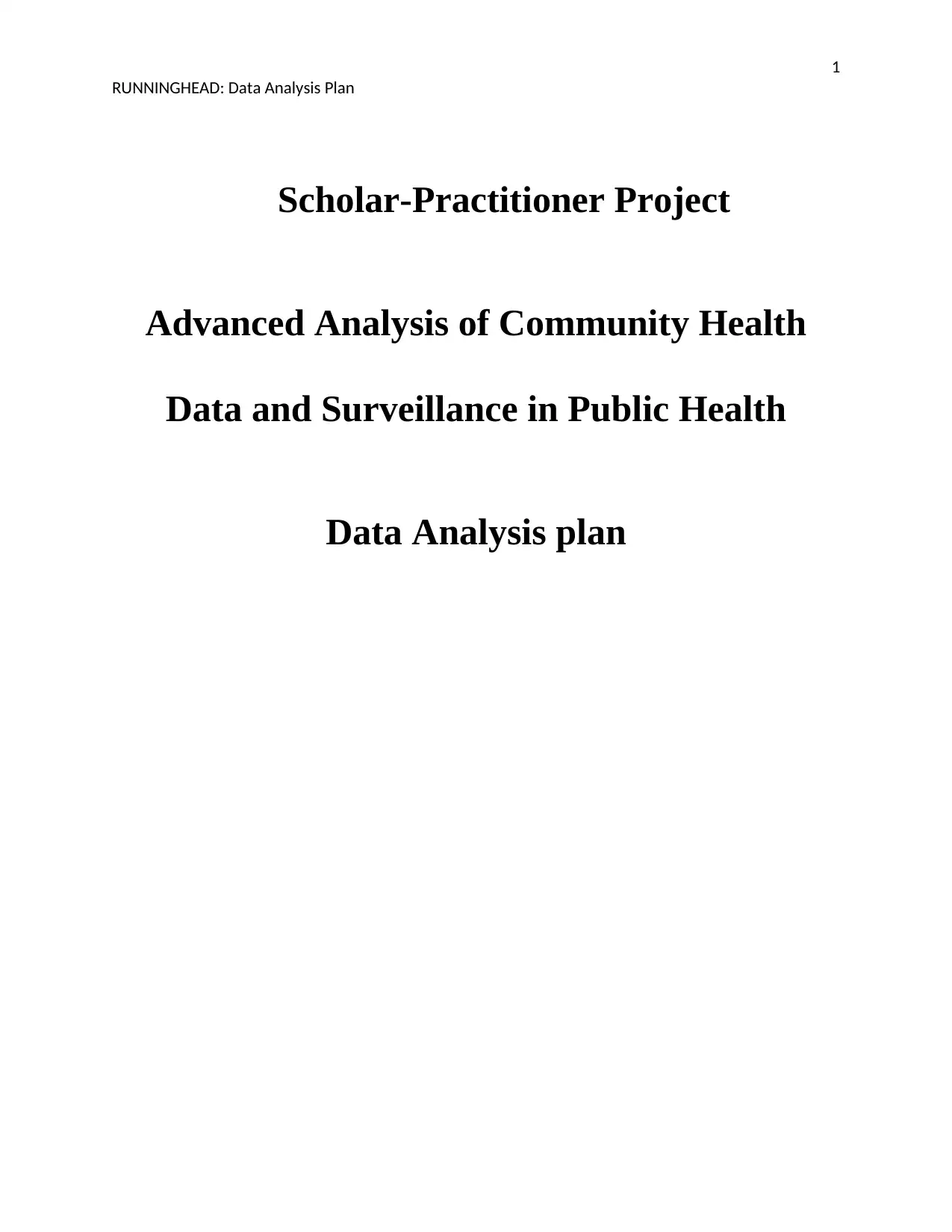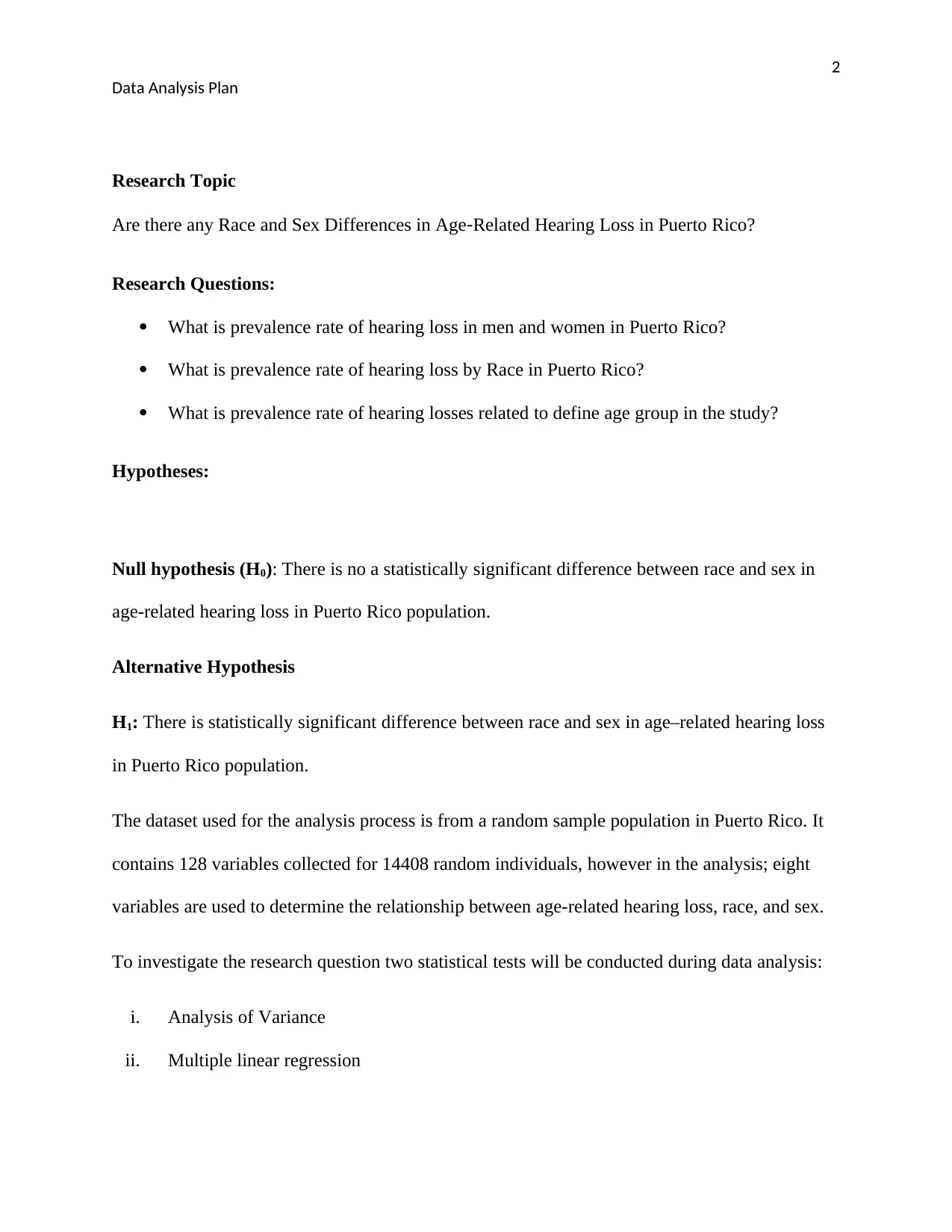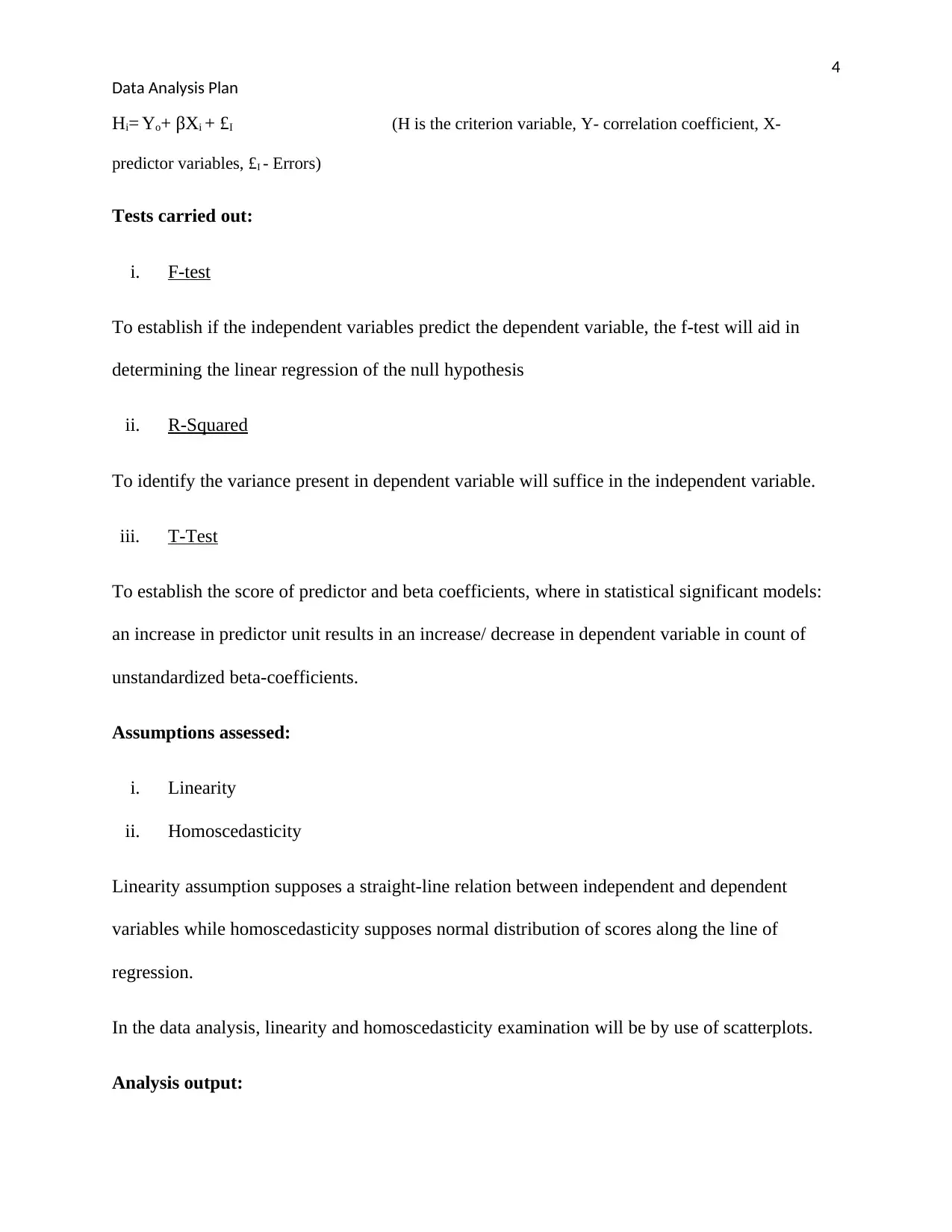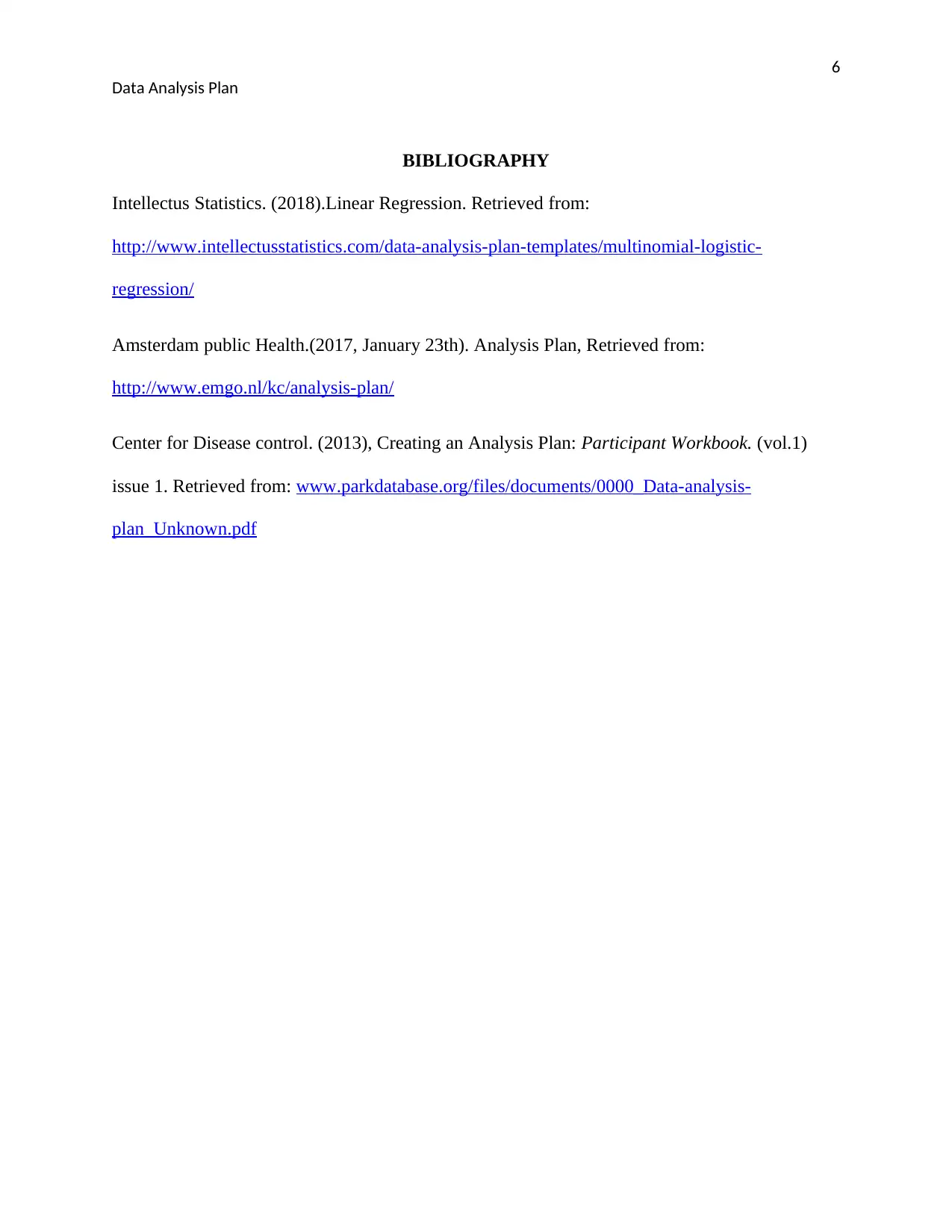PUBH 8545: Data Analysis Plan - Hearing Loss in Puerto Rico Study
VerifiedAdded on 2023/06/14
|6
|810
|453
Project
AI Summary
This data analysis plan investigates race and sex differences in age-related hearing loss within a Puerto Rican population. The research questions focus on the prevalence of hearing loss in men and women, across different racial groups, and within specific age groups. The hypothesis proposes a statistically significant difference between race and sex in age-related hearing loss. The plan outlines the use of ANOVA and multiple linear regression to analyze a dataset of 14408 individuals with eight key variables. It details the assumptions, tests (F-test, R-squared, T-test), and expected outputs, including graphs and statistical tables, to determine the relationship between independent variables (age, gender, race, noise frequency, occupational exposure, income, socio-economic status) and the dependent variable (hearing loss).

1
RUNNINGHEAD: Data Analysis Plan
Scholar-Practitioner Project
Advanced Analysis of Community Health
Data and Surveillance in Public Health
Data Analysis plan
RUNNINGHEAD: Data Analysis Plan
Scholar-Practitioner Project
Advanced Analysis of Community Health
Data and Surveillance in Public Health
Data Analysis plan
Paraphrase This Document
Need a fresh take? Get an instant paraphrase of this document with our AI Paraphraser

2
Data Analysis Plan
Research Topic
Are there any Race and Sex Differences in Age‐Related Hearing Loss in Puerto Rico?
Research Questions:
What is prevalence rate of hearing loss in men and women in Puerto Rico?
What is prevalence rate of hearing loss by Race in Puerto Rico?
What is prevalence rate of hearing losses related to define age group in the study?
Hypotheses:
Null hypothesis (H0): There is no a statistically significant difference between race and sex in
age-related hearing loss in Puerto Rico population.
Alternative Hypothesis
H1: There is statistically significant difference between race and sex in age–related hearing loss
in Puerto Rico population.
The dataset used for the analysis process is from a random sample population in Puerto Rico. It
contains 128 variables collected for 14408 random individuals, however in the analysis; eight
variables are used to determine the relationship between age-related hearing loss, race, and sex.
To investigate the research question two statistical tests will be conducted during data analysis:
i. Analysis of Variance
ii. Multiple linear regression
Data Analysis Plan
Research Topic
Are there any Race and Sex Differences in Age‐Related Hearing Loss in Puerto Rico?
Research Questions:
What is prevalence rate of hearing loss in men and women in Puerto Rico?
What is prevalence rate of hearing loss by Race in Puerto Rico?
What is prevalence rate of hearing losses related to define age group in the study?
Hypotheses:
Null hypothesis (H0): There is no a statistically significant difference between race and sex in
age-related hearing loss in Puerto Rico population.
Alternative Hypothesis
H1: There is statistically significant difference between race and sex in age–related hearing loss
in Puerto Rico population.
The dataset used for the analysis process is from a random sample population in Puerto Rico. It
contains 128 variables collected for 14408 random individuals, however in the analysis; eight
variables are used to determine the relationship between age-related hearing loss, race, and sex.
To investigate the research question two statistical tests will be conducted during data analysis:
i. Analysis of Variance
ii. Multiple linear regression

3
Data Analysis Plan
An ANOVA (analysis of covariance) test is conducted to examine statistical significant
difference between age-related hearing loss (dependent variable) by race and sex (independent
variables). When determining whether there exists mean differences in researching relationship
between continuous dependent variable with an independent variable from different discrete
groups, we conduct ANOVA statistical analysis for its sufficiency. When conducting ANOVA
discrete groups will be age, gender, race, frequency of noise, occupational exposure, income, and
socio-economic status while the analysis dependent variable will be loss of hearing.
Assumptions assessed:
i. Homogeneity
ii. Normality
In assumption of normality supposes the test variables to be normally distributed; the test uses
Kolmogorov-Smirnov test. Whereas, Variance homogeneity supposes that the groups have
identical variance errors, evaluated using Levene’s test for uniformity of variance errors. In
testing the probability of rejecting the null hypothesis to ensure the differences did not happen by
chance, the t test will be conducted to determine p-value. Where if p<0.05then we accept the null
hypothesis.
Additionally, in order to determine the relationship between independent variables (age, gender,
race, frequency of noise, occupational exposure, income, and socio-economic) and independent
variable (loss of hearing), the linear regression will be a sufficient statistical analysis. In the
linear regression analysis, the independent variable will be the predictor variable and the
independent variable be the criterion variable.
Regression equation used:
Data Analysis Plan
An ANOVA (analysis of covariance) test is conducted to examine statistical significant
difference between age-related hearing loss (dependent variable) by race and sex (independent
variables). When determining whether there exists mean differences in researching relationship
between continuous dependent variable with an independent variable from different discrete
groups, we conduct ANOVA statistical analysis for its sufficiency. When conducting ANOVA
discrete groups will be age, gender, race, frequency of noise, occupational exposure, income, and
socio-economic status while the analysis dependent variable will be loss of hearing.
Assumptions assessed:
i. Homogeneity
ii. Normality
In assumption of normality supposes the test variables to be normally distributed; the test uses
Kolmogorov-Smirnov test. Whereas, Variance homogeneity supposes that the groups have
identical variance errors, evaluated using Levene’s test for uniformity of variance errors. In
testing the probability of rejecting the null hypothesis to ensure the differences did not happen by
chance, the t test will be conducted to determine p-value. Where if p<0.05then we accept the null
hypothesis.
Additionally, in order to determine the relationship between independent variables (age, gender,
race, frequency of noise, occupational exposure, income, and socio-economic) and independent
variable (loss of hearing), the linear regression will be a sufficient statistical analysis. In the
linear regression analysis, the independent variable will be the predictor variable and the
independent variable be the criterion variable.
Regression equation used:
⊘ This is a preview!⊘
Do you want full access?
Subscribe today to unlock all pages.

Trusted by 1+ million students worldwide

4
Data Analysis Plan
Hi= Yo+ βXi + £I (H is the criterion variable, Y- correlation coefficient, X-
predictor variables, £I - Errors)
Tests carried out:
i. F-test
To establish if the independent variables predict the dependent variable, the f-test will aid in
determining the linear regression of the null hypothesis
ii. R-Squared
To identify the variance present in dependent variable will suffice in the independent variable.
iii. T-Test
To establish the score of predictor and beta coefficients, where in statistical significant models:
an increase in predictor unit results in an increase/ decrease in dependent variable in count of
unstandardized beta-coefficients.
Assumptions assessed:
i. Linearity
ii. Homoscedasticity
Linearity assumption supposes a straight-line relation between independent and dependent
variables while homoscedasticity supposes normal distribution of scores along the line of
regression.
In the data analysis, linearity and homoscedasticity examination will be by use of scatterplots.
Analysis output:
Data Analysis Plan
Hi= Yo+ βXi + £I (H is the criterion variable, Y- correlation coefficient, X-
predictor variables, £I - Errors)
Tests carried out:
i. F-test
To establish if the independent variables predict the dependent variable, the f-test will aid in
determining the linear regression of the null hypothesis
ii. R-Squared
To identify the variance present in dependent variable will suffice in the independent variable.
iii. T-Test
To establish the score of predictor and beta coefficients, where in statistical significant models:
an increase in predictor unit results in an increase/ decrease in dependent variable in count of
unstandardized beta-coefficients.
Assumptions assessed:
i. Linearity
ii. Homoscedasticity
Linearity assumption supposes a straight-line relation between independent and dependent
variables while homoscedasticity supposes normal distribution of scores along the line of
regression.
In the data analysis, linearity and homoscedasticity examination will be by use of scatterplots.
Analysis output:
Paraphrase This Document
Need a fresh take? Get an instant paraphrase of this document with our AI Paraphraser

5
Data Analysis Plan
The output of the analysis will be graphed and important statistics used to test the null and
alternative hypothesis. The ANOVA table will be used to identify important statistics such as the
mean of variances, whereas the linear regression will be used to plot scatterplots, boxplots and in
fitting of the response variable with predictor variables.
The data analysis output will be used to answer the question whether there is a difference in age
and sex in age-related loss.
Data Analysis Plan
The output of the analysis will be graphed and important statistics used to test the null and
alternative hypothesis. The ANOVA table will be used to identify important statistics such as the
mean of variances, whereas the linear regression will be used to plot scatterplots, boxplots and in
fitting of the response variable with predictor variables.
The data analysis output will be used to answer the question whether there is a difference in age
and sex in age-related loss.

6
Data Analysis Plan
BIBLIOGRAPHY
Intellectus Statistics. (2018).Linear Regression. Retrieved from:
http://www.intellectusstatistics.com/data-analysis-plan-templates/multinomial-logistic-
regression/
Amsterdam public Health.(2017, January 23th). Analysis Plan, Retrieved from:
http://www.emgo.nl/kc/analysis-plan/
Center for Disease control. (2013), Creating an Analysis Plan: Participant Workbook. (vol.1)
issue 1. Retrieved from: www.parkdatabase.org/files/documents/0000_Data-analysis-
plan_Unknown.pdf
Data Analysis Plan
BIBLIOGRAPHY
Intellectus Statistics. (2018).Linear Regression. Retrieved from:
http://www.intellectusstatistics.com/data-analysis-plan-templates/multinomial-logistic-
regression/
Amsterdam public Health.(2017, January 23th). Analysis Plan, Retrieved from:
http://www.emgo.nl/kc/analysis-plan/
Center for Disease control. (2013), Creating an Analysis Plan: Participant Workbook. (vol.1)
issue 1. Retrieved from: www.parkdatabase.org/files/documents/0000_Data-analysis-
plan_Unknown.pdf
⊘ This is a preview!⊘
Do you want full access?
Subscribe today to unlock all pages.

Trusted by 1+ million students worldwide
1 out of 6
Related Documents
Your All-in-One AI-Powered Toolkit for Academic Success.
+13062052269
info@desklib.com
Available 24*7 on WhatsApp / Email
![[object Object]](/_next/static/media/star-bottom.7253800d.svg)
Unlock your academic potential
Copyright © 2020–2026 A2Z Services. All Rights Reserved. Developed and managed by ZUCOL.





